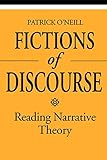Fictions of discourse : reading narrative theory / Patrick O'Neill.
Material type: TextSeries: Theory/culture seriesPublication details: Toronto ; Buffalo : University of Toronto Press, ©1996.Description: 1 online resource (x, 188 pages) : illustrationsContent type:
TextSeries: Theory/culture seriesPublication details: Toronto ; Buffalo : University of Toronto Press, ©1996.Description: 1 online resource (x, 188 pages) : illustrationsContent type: - text
- computer
- online resource
- 9781442674868
- 1442674865
- 808 22
- PN212 .O49 1996eb
| Item type | Home library | Collection | Call number | Materials specified | Status | Date due | Barcode | |
|---|---|---|---|---|---|---|---|---|
 Electronic-Books
Electronic-Books
|
OPJGU Sonepat- Campus | E-Books EBSCO | Available |
Includes bibliographical references (pages 169-180) and index.
Print version record.
Contents -- Acknowledgments -- Introduction -- 1 Theory Games: Narratives and Narratologies -- 2 Narrative Facts and Other Fictions: Story and Discourse -- 3 Discourse Discoursed: The Ventriloquism Effect -- 4 Points of Origin: The Focalization Factor -- 5 Texts and Textuality: The Shapers and the Shaped -- 6 Games Texts Play: Reading between the Narratives -- Conclusion -- NOTES -- BIBLIOGRAPHY -- INDEX -- A -- B -- C -- D -- E -- F -- G -- H -- I -- J -- K -- L -- M -- N -- O -- P -- Q -- R -- S -- T -- V -- W -- Z
The fundamental principle upon which contemporary narratology is constructed is that narrative is an essentially divided endeavour, involving the story (`what really happened') and the discourse (`how what happened is presented'). For traditional criticism, the primary task of narrative discourse is essentially to convey the story as transparently as possible. Patrick O'Neill investigates the extent to which narrative discourse also contains the counter-tendency not to tell the story, indeed to subvert the story it tells in foregrounding its own performance. The systemic implications of this perspective for narrative and for narrative theory are examined within the conceptual framework provided by classical French narratology. O'Neill ultimately attempts both to expand and to problematize the structural model of narrative proposed by this centrally important tradition of narrative theory. O'Neill describes narrative as functioning in terms of four interacting levels: story, narrative text, narration, and textuality. Using a range of examples from Homer to modern European fiction, he discusses traditional narrative categories such as voice, focalization, character, and setting, and reinscribes them within the contextual space of author and reader to bring out narrative's potential for ambiguity and unreliability. He also discusses the implications of translation for narrative theory.
eBooks on EBSCOhost EBSCO eBook Subscription Academic Collection - Worldwide
There are no comments on this title.

